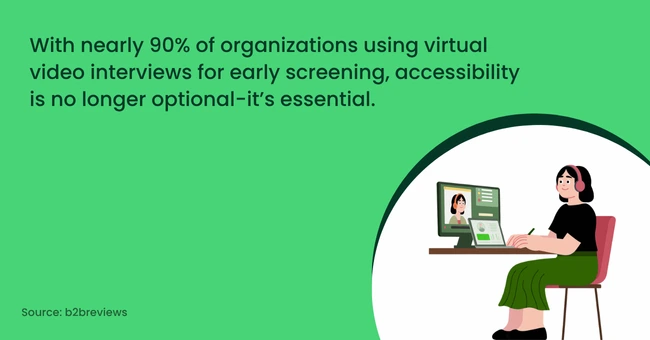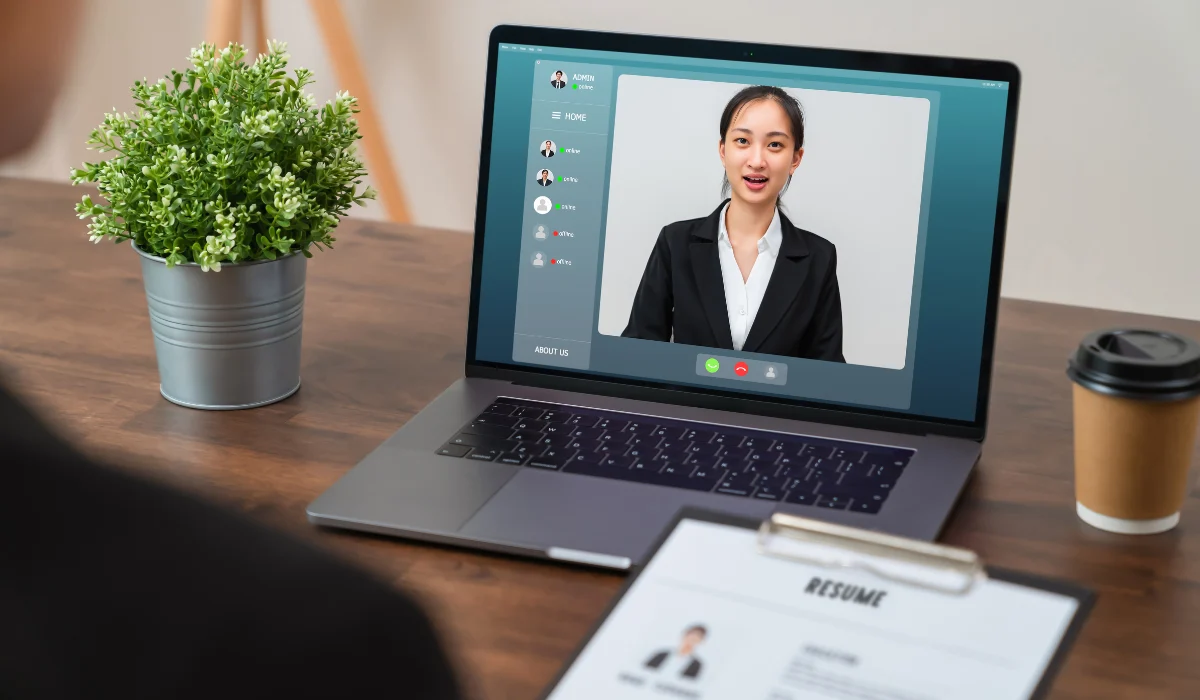
How to Make Accessible One-Way Interview Screening Inclusive
Nov 17, 2025 |
The hiring landscape has undergone a dramatic transformation with the adoption of digital recruitment tools. Among these innovations, accessible one-way interview screening has emerged as a powerful solution for organizations seeking to evaluate candidates efficiently while maintaining fairness.
As companies increasingly embrace remote work and distributed teams, creating an inclusive screening process isn't just ethical-it's essential for accessing the broadest talent pool possible. When done right, accessible one-way interview screening benefits candidates by offering flexibility, helps recruiters save time, and ensures organizations don't miss out on exceptional talent due to unnecessary barriers.
TL;DR
- - Ensure interview platforms support captions, screen readers, keyboard navigation, and low bandwidth.
- - Standardize questions to reduce bias and improve fairness in candidate evaluation.
- - Provide clear instructions, practice questions, and multi-channel support to improve candidate experience.
- - Address common barriers like tech limitations, unclear expectations, and accessibility gaps.
- - Use AI responsibly, audit results regularly, and collect candidate feedback to improve inclusivity.
With around 90% of organizations now using virtual video interviews in their early screening stages, accessibility has become a critical requirement rather than an optional feature [Source].

Understanding Accessible One-Way Interview Screening
Accessible one-way interview screening refers to asynchronous video interview processes designed to accommodate candidates of all abilities, backgrounds, and circumstances.
Unlike traditional interviews that require real-time interaction, this approach allows candidates to record responses to pre-set questions on their own schedule. The "accessible" component means the technology and process are designed with inclusivity at their core, considering factors like visual or hearing impairments, neurodiversity, technological limitations, and language differences.
Key elements of an inclusive video interview screening process include multiple ways to interact with content, adjustable time limits, clear instructions, technical support availability, and transparent evaluation criteria. When implemented thoughtfully, asynchronous interview screening can actually be more equitable than traditional methods by standardizing questions and reducing unconscious bias that sometimes occurs in live conversations.
Common Accessibility Challenges in One-Way Interviews
Despite their potential, remote interview screening platforms can present significant barriers if not carefully designed. Technical challenges often top the list-candidates may lack high-speed internet, professional recording equipment, or the latest devices. These infrastructure gaps disproportionately affect candidates from lower-income backgrounds or rural areas, inadvertently creating inequity in what should be a fair candidate screening process.
Bias and fairness issues persist even in digital formats. Algorithms used in automated candidate screening can perpetuate existing prejudices if trained on non-diverse datasets. Similarly, evaluators reviewing recorded responses may still harbor unconscious biases around accents, appearance, or communication styles. The absence of real-time dialogue in accessible hiring processes also means candidates can't ask clarifying questions or gauge interviewer reactions, which can disadvantage those who thrive in conversational settings.
Candidate experience gaps represent another critical challenge. Without proper guidance, applicants may feel uncertain about technical requirements, optimal video length, or what constitutes a strong response. This ambiguity particularly affects first-time users of video interview technology or those from backgrounds where such tools aren't standard practice.
Essential Features of Accessible One-Way Interview Technology
Creating truly accessible one-way interview screening requires thoughtful technology selection. The most inclusive platforms offer closed captioning for all video and audio content, ensuring candidates with hearing impairments can fully participate. Screen reader compatibility allows visually impaired candidates to navigate the interface independently, while keyboard-only navigation options serve those unable to use a mouse.
High-quality automated candidate screening tools should include adjustable playback speeds, the ability to review questions multiple times, and flexible response windows that accommodate different processing speeds. Some platforms now offer text-based response options alongside video recording, recognizing that not all candidates have access to cameras or feel comfortable on video.
Compatibility across devices and platforms is non-negotiable for scalable interview screening. Your chosen solution should function smoothly on smartphones, tablets, and computers running various operating systems. This flexibility ensures candidates aren't excluded based on their available technology. Consider platforms that require minimal bandwidth and offer offline preparation options, addressing connectivity challenges that impact remote hiring accessibility.
Creating Inclusive Screening: Best Practices
Implementing structured video interviews represents one of the most effective strategies for screening bias reduction. By asking every candidate the same questions in the same order, you create a standardized evaluation framework that minimizes the influence of irrelevant factors. This consistency also makes it easier to compare candidates fairly based on competencies rather than presentation style.
Crafting inclusive questions requires careful consideration. Avoid language that might confuse non-native speakers or assume specific cultural knowledge. Focus on job-relevant scenarios and competencies rather than hypotheticals that might advantage certain educational backgrounds. Questions should be clear, concise, and directly tied to role requirements.
Providing candidates with comprehensive, accessible instructions dramatically improves their experience and performance. Create step-by-step guides with screenshots, offer practice questions, and clearly communicate technical requirements well in advance. Consider producing tutorial videos with captions and transcripts. Make support resources available through multiple channels-email, phone, and chat-to accommodate different communication preferences and accessibility needs.
Enhancing Fair Candidate Screening Through Technology
Modern technology offers powerful tools for screening bias reduction when deployed thoughtfully. AI-powered systems can help standardize scoring by focusing on response content rather than delivery, though these tools require careful monitoring to ensure they don't introduce new biases. Some organizations use blind evaluation features that initially hide candidate names, photos, and other identifying information from reviewers.
Regular auditing of your accessible hiring process is essential. Analyze completion rates across demographic groups to identify potential barriers. Review your question bank for unintentional bias. Gather feedback from candidates about their experience, particularly regarding accessibility features. This continuous improvement mindset helps ensure your video interview inclusivity efforts remain effective as your candidate pool and technology evolve.
Leveraging scalable interview screening solutions allows you to maintain high accessibility standards even when hiring volume increases. Automation should enhance rather than replace human judgment. Use technology to handle logistics and initial screening while preserving human evaluation for nuanced assessment. The best video interview platforms balance efficiency with the personal touch candidates appreciate.
Remote Hiring Accessibility: What Recruiters Should Know
Remote hiring accessibility presents unique considerations that go beyond technical features. Time zone differences, for instance, can create challenges even in asynchronous formats if response windows are too short. Cultural norms around video communication vary globally, with some candidates feeling uncomfortable with self-presentation while others excel in this format.
Building a candidate-friendly, accessible hiring process means anticipating these differences and building in flexibility. Offer extended response periods for international candidates. Provide cultural context for your questions when hiring across borders. Consider offering alternative assessment methods for roles where video communication isn't a core competency. The goal is to evaluate capability for the job, not comfort with specific interview technology.
Measuring the effectiveness of your video interview inclusivity efforts requires both quantitative and qualitative data. Track metrics like completion rates, time-to-hire, and candidate diversity at each hiring stage. Equally important is gathering candidate feedback through post-interview surveys. Ask specific questions about accessibility features, technical difficulties, and overall experience. This data helps you identify improvement opportunities and demonstrates your commitment to inclusive hiring practices.
Future Trends in Accessible Recruitment Technology
The evolution of accessible recruitment technology continues to accelerate. Emerging tools now offer real-time translation services, expanding access for multilingual candidates. Virtual reality practice environments help candidates familiarize themselves with asynchronous interview formats in low-stakes settings. Enhanced mobile applications recognize that smartphone-based screening may be the only option for many qualified candidates.
AI's role in accessible recruitment technology is expanding beyond simple screening. Machine learning algorithms can now identify and flag potentially biased language in job descriptions and interview questions. Predictive analytics help recruiters understand which accessibility features have the greatest impact on candidate completion rates and satisfaction. Some experimental systems even adjust question complexity in real-time based on candidate responses, personalizing the experience while maintaining fairness.
Continuous improvement of accessible one-way interview screening will likely focus on personalization within standardization, maintaining the fairness benefits of structured approaches while accommodating individual needs more elegantly. Expect to see more sophisticated accommodation request systems, better integration with assistive technologies, and enhanced transparency around how candidate responses are evaluated.
Conclusion
Prioritizing inclusion in accessible one-way interview screening isn’t just about compliance or good intentions-it’s a strategic move that broadens your talent pool and strengthens your employer brand. Candidates increasingly judge employers by the accessibility of their hiring process, often sharing their experiences publicly, which makes accessibility essential for maintaining a positive reputation.
To create truly accessible practices, begin by auditing your current process, investing in inclusive technology, and training recruiters on accessibility standards. Involve candidates with disabilities and those from underrepresented groups to uncover gaps you may overlook, and treat accessibility as an ongoing commitment that evolves with technology and workforce needs. Continuous improvement and genuine attention to candidate feedback will help you build a fairer hiring process and a more diverse, innovative team that reflects modern organizational values.
Frequently Asked Questions (FAQs)
1. What is an accessible one-way interview?
An accessible one-way interview is an asynchronous video screening designed so all candidates can participate without barriers.
2. How do companies make one-way interviews inclusive?
They ensure inclusivity by adding captions, flexible timing, clear instructions, and multiple response options.
3. Why are accessible one-way interviews important?
They create fair hiring opportunities and help organizations reach a wider, more diverse talent pool.
4. What accessibility features should interview platforms include?
Platforms should include captions, screen-reader support, keyboard navigation, and low-bandwidth compatibility.
5. How can candidates prepare for a one-way video interview?
Candidates can prepare by testing their tech, reviewing instructions, and using any available accessibility settings.







